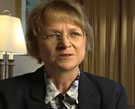|
INTERVIEW
TRANSCRIPT - Dr. Meryl Williams
There is a very strong connection between aquaculture and ocean fisheries. The connection comes though several streams, through the markets, and the price of fish is affected by what’s happening in both sectors, but also very much through the environment and feeds. Feeds in certain types of aquaculture are one of the strongest links, so using fishmeal from captured fisheries or even trashed fish — sometimes it’s not reduced to fishmeal. To feed aquaculture species such as shrimps, groupers, and sea bass is a very important and growing factor in world fish production. When you’re feeding fish to make fish, you actually end up with less fish. It makes economic sense but it doesn’t increase the amount of fish available in the world. So I think we need to re-look very carefully at the linkages between aquaculture and fisheries, because some of the original assumptions are not at all true.
I know, that’s true all over Asia; the trawlers bring in the non-human food fish not even through the markets, it goes often directly to the fish farms to the coastal cages. I’ve been in parts of Asia, where I’ve seen the transfer happening. Now we have a small boat ourselves in Panang, and you see the transfer happening directly. So there’s a definite use of local fish from local seas for fish farming.
Nobody has those figures. I would think, although that would be a very interesting study to do, because I think some of the assumptions about where the fishmeal comes from is, again, the assumptions are wrong that it all comes from Peru or whatever. But certainly a lot of it does come from local areas. Market forces would be the determining factor. What prices are they able to buy the food from locally, what can people afford is what determines price. Formulated fish feeds are usually much better because they embody a lot of knowledge. They’re usually cleaner, more concentrated, and more balanced in nutrient composition. If you take direct trash fish you don’t really, as a farmer, know what the balance of nutrients are that you’re feeding to your fish. It’s certainly an area that hasn’t really received the attention that it deserves. But that’s changing very quickly.
From local supplies. That’s an interesting observation; it’s one that I would believe. I’m not aware of any studies that look at that percentage. It would be very worthwhile knowing. I have a general belief that one of the really important things to do for aquaculture for the future, particularly at the national level, is to do much more thorough planning and analysis. There are huge events happening in a very ad hoc way: everything from changes in where the feeds come from to the conversion of natural environments to farming, et cetera. Many of the countries all around the world, not just in Southeast Asia, have great projections for what they’d like to get out of production in the long term from aquaculture. But in my view, they haven’t put enough thought into how they’re going to get there. They know what they need, and they’ve started to look at what they need for the future to replace more fishing ports for instance, or to make more money out of fish exports. But, they haven’t thought what species they should be growing, where the markets are, what areas and resources they have to farm those fish, how much water, where the land is, and what type of land. In fact, there is blindness in a lot of parts of the world in aquaculture and these issues need to be addressed overall. There just needs
to be a much more strategic planning framework for this very fast
developing, but loosely developing, industry. It is the fastest
growing food production system in the world, aquaculture. It’s
been averaging nearly 10% a year for the last 10 to 15 years. No
other form of food production comes near it. Livestock considers
itself a fast grower, 2 to 3% production per year. But aquaculture
is much faster than that. It’s not really getting the attention
or national agenda from the fisheries department, because it’s
not just a fisheries department issue. The finance ministry should
be looking at it.
Yes and it’s not even by any means. China dominates and we know the Chinese figures are not totally sure as they now stand. But that aside, we do know China produces an enormous amount of fish and that amount has grown enormously in the last two to three decades. India is the second biggest fish producer in the world now, and that’s a great surprise. Aquaculture is absolutely booming in India. Just in the last decade it’s gone from producing only one-third to now about 40% of fish production in India. It’s definitely going ahead faster. Of course the Southeast Asian countries of Thailand and Vietnam are a very burgeoning aquaculture producer. Vietnam now exports over a billion dollars of fish, of seafood, per year. Three times the amount of rice and second in foreign exports only to petroleum products. For those sorts of reasons, it should be on the national agenda, not just on the fisheries department agendas.
It’s a
mixture. There’s no doubt that where the opportunity exists
there are incentives, either at the national level or with the private
individual, to get into the higher value export crops. There have
been quite deep shocks in some countries when a market is cutoff.
In many countries, there is a large growth in the food security
end of production. We’ve been working in several of those
countries and we’ve had very big involvement with the world
fish center in Bangladesh in aquacultural development. |
 Meryl
Williams is the Director General of The World Fish Center.
Headquarters is in Panang, Malaysia.
Meryl
Williams is the Director General of The World Fish Center.
Headquarters is in Panang, Malaysia.